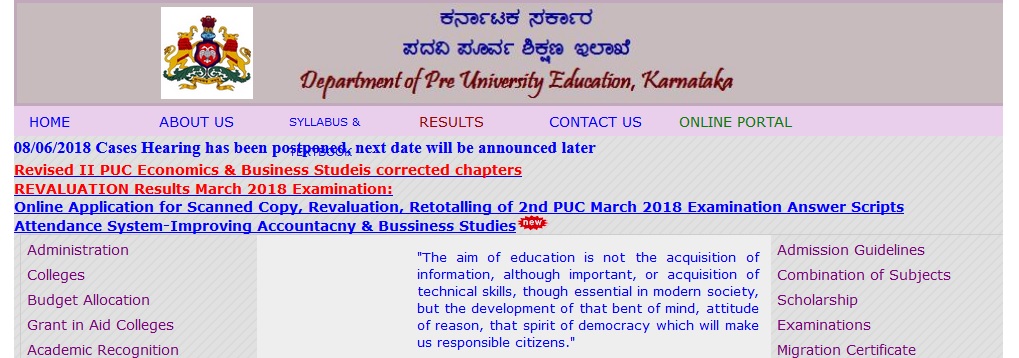PUC/ Pre University Physics II Model Question Paper : www.pue.kar.nic.in Karnataka
Organization : Karnataka Department of Pre-University Education
Exam : II PU Physics
Document type : Question Paper
Website : pue.kar.nic.in
Download Previous/ Old Question Papers :
April 2006 : https://www.pdfquestion.in/uploads/pue.kar.nic.in/5962-a0633.pdf
April 2007 : https://www.pdfquestion.in/uploads/pue.kar.nic.in/5962-a0733.pdf
March 2008 : https://www.pdfquestion.in/uploads/pue.kar.nic.in/5962-m0833.pdf
June 2008 : https://www.pdfquestion.in/uploads/pue.kar.nic.in/5962-j0833.pdf
March 2009 : https://www.pdfquestion.in/uploads/pue.kar.nic.in/5962-m0933.pdf
July 2009 : https://www.pdfquestion.in/uploads/pue.kar.nic.in/5962-j0933.pdf
March 2010 : https://www.pdfquestion.in/uploads/pue.kar.nic.in/5962-m1033.pdf
July 2010 : https://www.pdfquestion.in/uploads/pue.kar.nic.in/5962-j1033.pdf
March 2011 : https://www.pdfquestion.in/uploads/pue.kar.nic.in/5962-m1133.pdf
July 2011 : https://www.pdfquestion.in/uploads/pue.kar.nic.in/5962-j1133.pdf
March 2014 :https://www.pdfquestion.in/uploads/pue.kar.nic.in/5962-m1433.pdf
Physics Question Paper :
New Scheme ( For Students studied during the Year 2005-2006 )
Code No. 33-NS Total No. of Questions : 40 ] [ Total No. of Printed Pages : 16
Related / Similar Question Paper :
Karnataka PUC Chemistry II Model Question Paper
March / April, 2006
( New Syllabus )
Time : 3 Hours ] [ Max. Marks : 90
Note : i) Numerical problems solved without writing the relevant formulae carry no marks.
ii) Answers without relevant diagram / figure / circuit wherever necessary will not carry any marks.
PART – A :
I. Answer all of the following questions :
1. Define dispersive power of a medium for a pair of colours.
2. Which type of wavefront is used in Fraunhoffer diffraction –
3. Mention any one factor on which resolving power of a telescope depends.
4. What is the value of speed of light obtained in Michelson’s rotating mirror
5. State Gauss’ theorem in electrostatics.
6. Write the colour code for a resistor of resistance 120 O .
7. What is the magnitude of the force exerted on a charge which is
8. What is M.R.I. –
9. Write the circuit symbol of ‘AND’ gate.
10. Give an example of a gel.

PART – B :
II. Answer any ten of the following questions :
11. What is a thin prism – Write the expression for deviation produced by a thin prism.
12. Mention the significance of Hertz’s experiment and write the
13. The diameter of the objective of a telescope is 1·2 m. If the
wavelength of light used is 546 nm, calculate the limit of resolution of telescope.
14. Give the representation of plane polarised and unpolarised light.
15. Write the expression for Coulomb force between two point charges
separated by a distance in vector form and explain the terms.
PART – C
III. Answer any one of the following questions :
23. What is ‘normal shift’ – Obtain an expression for the normal shift
produced, when an object in a denser medium is viewed normally through air.
24. Give the theory of interference of light and hence arrive at the
IV. Answer any two of the following questions :
25. Derive the expression for magnetic field at any point on the axis of a
26. Give the construction and working of a transformer. Mention any one
27. Explain the experimental observations of photoelectric effect.
V. Answer any two of the following questions :
28. Arrive at the expression for radius of first Bohr orbit of hydrogen like atom.
29. Derive N = N 0 e – – t . Hence define decay constant.
30. i) Classify conductors, semiconductors and insulators based on band theory of
VI. Answer any three of the following questions :
31. A small air bubble is found 0·04 m inside the glass sphere of
refractive index 1·5. When viewed normally from outside it is seen at
a depth of 0·03 m. Caculate the radius of curvature of glass sphere.
32. Two charges 5 µC and – 5 µC are placed at points A and B, which
are separated by a distance of 0·06 m. Find the electric field
March / April, 2007
Part – A :
I. Answer all of the following questions : 10 × 1 = 10
1. What is the principle of an optical fibre ?
2. Write the condition for constructive interference in terms of pathdifference.
3. Define specific rotatory power of an optically active solution.
4. Name the scientist who determined the speed of light most accurately.
5. What happens to the magnitude of the force between two charges if a glass plate is interposed between them ?
6. Mention the S.I. unit of resistivity.
7. Does a neutron experience a force in a magnetic field ?
8. What are ‘Fraunhofer lines’ ?
9. Is proton a Lepton or a Hadron ?
10. Write the logic symbol of NAND gate.
Part – B :
II. Answer any ten of the following questions : 10 × 2 = 20
11. Mention any two factors on which lateral shift depends.
12. Name the theories of light in support of its wave nature.
13. Calculate the resolving power of a telescope whose limit of resolution is 2·44 × 10 – 6 rad. 14. State and explain Gauss’ theorem.
15. With a labelled diagram, write the expression for the capacitance of a spherical capacitor.